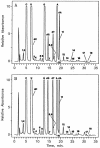Influence of temperature on tRNA modification in archaea: Methanococcoides burtonii (optimum growth temperature [Topt], 23 degrees C) and Stetteria hydrogenophila (Topt, 95 degrees C)
- PMID: 12949100
- PMCID: PMC193749
- DOI: 10.1128/JB.185.18.5483-5490.2003
Influence of temperature on tRNA modification in archaea: Methanococcoides burtonii (optimum growth temperature [Topt], 23 degrees C) and Stetteria hydrogenophila (Topt, 95 degrees C)
Abstract
We report the first study of tRNA modification in psychrotolerant archaea, specifically in the archaeon Methanococcoides burtonii grown at 4 and 23 degrees C. For comparison, unfractionated tRNA from the archaeal hyperthermophile Stetteria hydrogenophila cultured at 93 degrees C was examined. Analysis of modified nucleosides using liquid chromatography-electrospray ionization mass spectrometry revealed striking differences in levels and identities of tRNA modifications between the two organisms. Although the modification levels in M. burtonii tRNA are the lowest in any organism of which we are aware, it contains more than one residue per tRNA molecule of dihydrouridine, a molecule associated with maintenance of polynucleotide flexibility at low temperatures. No differences in either identities or levels of modifications, including dihydrouridine, as a function of culture temperature were observed, in contrast to selected tRNA modifications previously reported for archaeal hyperthermophiles. By contrast, S. hydrogenophila tRNA was found to contain a remarkable structural diversity of 31 modified nucleosides, including nine methylated guanosines, with eight different nucleoside species methylated at O-2' of ribose, known to be an effective stabilizing motif in RNA. These results show that some aspects of tRNA modification in archaea are strongly associated with environmental temperature and support the thesis that posttranscriptional modification is a universal natural mechanism for control of RNA molecular structure that operates across a wide temperature range in archaea as well as bacteria.
Figures



References
-
- Agris, P. F. 1996. The importance of being modified: roles of modified nucleosides and Mg2+ in RNA structure and function. Prog. Nucleic Acid Res. Mol. Biol. 53:79-129. - PubMed
-
- Agris, P. F., P. Koh, and D. Söll. 1973. The effect of growth temperature on the in vivo ribose methylation of Bacillus stearothermophilus. Arch. Biochem. Biophys. 154:277-282. - PubMed
-
- Andachi, Y., F. Yamao, A. Muto, and S. Osawa. 1989. Codon recognition patterns as deduced from sequences of the complete set of transfer RNA species in Mycoplasma capricolum. J. Mol. Biol. 209:37-54. - PubMed
-
- Auffinger, P., and E. Westhof. 1998. Location and distribution of modified nucleotides in tRNA, p. 569-576. In H. Grosjean and R. Benne (ed.), Modification and editing of RNA. ASM Press, Washington, D.C.
-
- Buck, M., M. Connick, and B. N. Ames. 1983. Complete analysis of tRNA-modified nucleosides by high performance liquid chromatography: the 29 modified nucleosides of Salmonella typhimurium and Escherichia coli tRNA. Anal. Biochem. 129:1-13. - PubMed
Publication types
MeSH terms
Substances
LinkOut - more resources
Full Text Sources
Molecular Biology Databases

